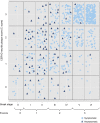Comparison of symptomatic and asymptomatic persons with Alzheimer disease neuropathology
- PMID: 23645594
- PMCID: PMC3716351
- DOI: 10.1212/WNL.0b013e318295d7a1
Comparison of symptomatic and asymptomatic persons with Alzheimer disease neuropathology
Abstract
Objectives: We sought to identify demographic and clinical features that were associated with expression of symptoms in the presence of Alzheimer disease (AD) neuropathologic changes.
Methods: We studied 82 asymptomatic (Clinical Dementia Rating global score = 0) and 824 symptomatic subjects (Clinical Dementia Rating score >0) with low to high AD neuropathologic changes at autopsy who were assessed at 1 of 34 National Institute on Aging-funded Alzheimer's Disease Centers. All subjects underwent a clinical examination within 1 year of death. Logistic regression was used to evaluate factors associated with the odds of being asymptomatic vs symptomatic.
Results: Asymptomatic subjects tended to have low neurofibrillary tangle scores but a wide range of neuritic plaque frequencies. There were, however, a few asymptomatic subjects with very high tangle and neuritic plaque burden, as well as symptomatic subjects with few changes. In the multivariable model, asymptomatic subjects were older (odds ratio [OR] = 1.04; 95% confidence interval [CI] = 1.01-1.07), had lower clinical Hachinski Ischemic Score (OR = 0.82; 95% CI = 0.69-0.97), were less likely to have an APOE ε4 allele (OR = 0.36; 95% CI = 0.16-0.83), and had lower neurofibrillary tangle score (OR = 0.28; 95% CI = 0.17-0.45) compared with symptomatic subjects.
Conclusions: Dissociating clinical symptoms from pathologic findings better allows for investigation of preclinical AD. Our results suggest that although the severity of the pathology, particularly neurofibrillary tangles, has a large role in determining the extent of symptoms, other factors, including age, APOE status, and comorbidities such as cerebrovascular disease also explain differences in clinical presentation.
Figures
Comment in
-
Journal Club: comparison of symptomatic and asymptomatic persons with Alzheimer disease neuropathology.Neurology. 2014 Mar 4;82(9):e76-8. doi: 10.1212/WNL.0000000000000164. Neurology. 2014. PMID: 24590252 Free PMC article.
Similar articles
-
Clinicopathologic studies in cognitively healthy aging and Alzheimer's disease: relation of histologic markers to dementia severity, age, sex, and apolipoprotein E genotype.Arch Neurol. 1998 Mar;55(3):326-35. doi: 10.1001/archneur.55.3.326. Arch Neurol. 1998. PMID: 9520006
-
Comparison of symptomatic and asymptomatic persons with primary age-related tauopathy.Neurology. 2017 Oct 17;89(16):1707-1715. doi: 10.1212/WNL.0000000000004521. Epub 2017 Sep 15. Neurology. 2017. PMID: 28916532 Free PMC article.
-
Increased Alzheimer's disease neuropathology is associated with type 2 diabetes and ApoE ε.4 carrier status.Curr Alzheimer Res. 2013 Jul;10(6):654-9. doi: 10.2174/15672050113109990006. Curr Alzheimer Res. 2013. PMID: 23627755 Free PMC article.
-
Characterizing Apolipoprotein E ε4 Carriers and Noncarriers With the Clinical Diagnosis of Mild to Moderate Alzheimer Dementia and Minimal β-Amyloid Peptide Plaques.JAMA Neurol. 2015 Oct;72(10):1124-31. doi: 10.1001/jamaneurol.2015.1721. JAMA Neurol. 2015. PMID: 26302353 Free PMC article.
-
Increased neocortical neurofibrillary tangle density in subjects with Alzheimer disease and psychosis.Arch Gen Psychiatry. 2000 Dec;57(12):1165-73. doi: 10.1001/archpsyc.57.12.1165. Arch Gen Psychiatry. 2000. PMID: 11115331
Cited by
-
Is pathological aging a successful resistance against amyloid-beta or preclinical Alzheimer's disease?Alzheimers Res Ther. 2014 May 6;6(3):24. doi: 10.1186/alzrt254. eCollection 2014. Alzheimers Res Ther. 2014. PMID: 25031637 Free PMC article.
-
Does Alzheimer Disease Pathologic Change Underlie Subjective Cognitive Complaints?Alzheimer Dis Assoc Disord. 2015 Oct-Dec;29(4):350-2. doi: 10.1097/WAD.0000000000000092. Alzheimer Dis Assoc Disord. 2015. PMID: 25973910 Free PMC article. No abstract available.
-
A review of the flortaucipir literature for positron emission tomography imaging of tau neurofibrillary tangles.Brain Commun. 2023 Nov 16;6(1):fcad305. doi: 10.1093/braincomms/fcad305. eCollection 2024. Brain Commun. 2023. PMID: 38187878 Free PMC article. Review.
-
The neurobiological basis of cognitive impairment in Parkinson's disease.Mov Disord. 2014 Apr 15;29(5):634-50. doi: 10.1002/mds.25857. Mov Disord. 2014. PMID: 24757112 Free PMC article. Review.
-
Lewy Bodies, Vascular Risk Factors, and Subcortical Arteriosclerotic Leukoencephalopathy, but not Alzheimer Pathology, are Associated with Development of Psychosis in Alzheimer's Disease.J Alzheimers Dis. 2016;50(1):283-95. doi: 10.3233/JAD-150606. J Alzheimers Dis. 2016. PMID: 26682680 Free PMC article.
References
-
- Roe CM, Xiong C, Miller JP, Morris JC. Education and Alzheimer disease without dementia: support for the cognitive reserve hypothesis. Neurology 2007;68:223–228 - PubMed
-
- Mirra SS, Heyman A, McKeel D, et al. The Consortium to Establish a Registry for Alzheimer's Disease (CERAD). Part II. Standardization of the neuropathologic assessment of Alzheimer's disease. Neurology 1991;41:479–486 - PubMed
Publication types
MeSH terms
Substances
Grants and funding
LinkOut - more resources
Full Text Sources
Other Literature Sources
Medical
Miscellaneous

